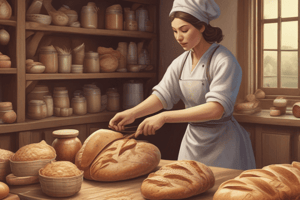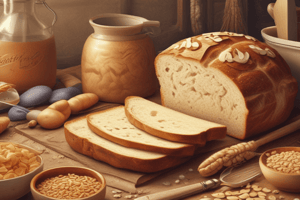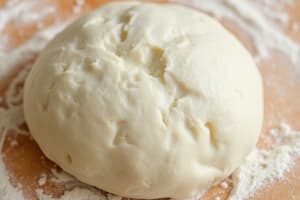Podcast
Questions and Answers
What is the primary role of gluten in bread making?
What is the primary role of gluten in bread making?
- To create a stretchy and elastic dough. (correct)
- To provide a food source for the yeast.
- To add flavor to the bread.
- To give the bread a golden-brown color.
Which type of flour is generally considered the best for bread making due to its high gluten content?
Which type of flour is generally considered the best for bread making due to its high gluten content?
- Bread flour (correct)
- All-purpose flour
- Pastry flour
- Cake flour
What gas is produced by yeast during fermentation that causes bread to rise?
What gas is produced by yeast during fermentation that causes bread to rise?
- Nitrogen
- Oxygen
- Carbon dioxide (correct)
- Hydrogen
What is the chemical formula for carbon dioxide?
What is the chemical formula for carbon dioxide?
Yeast requires specific conditions to thrive. Which of the following is NOT a key condition for yeast growth?
Yeast requires specific conditions to thrive. Which of the following is NOT a key condition for yeast growth?
Which of the following best describes yeast?
Which of the following best describes yeast?
Why is kneading an important step?
Why is kneading an important step?
How does 'proving' contribute to the bread-making process?
How does 'proving' contribute to the bread-making process?
Which of the following is MOST likely to be used to create a golden brown and shiny crust?
Which of the following is MOST likely to be used to create a golden brown and shiny crust?
During baking, what process primarily contributes to the bread's increase in volume (oven spring)?
During baking, what process primarily contributes to the bread's increase in volume (oven spring)?
Flashcards
What is gluten?
What is gluten?
A protein in wheat flour that gives dough its elasticity and strength.
What is the role of yeast in bread making?
What is the role of yeast in bread making?
A leavening agent that produces carbon dioxide through fermentation.
Why is water important in bread making?
Why is water important in bread making?
It keeps the dough moist, activates the yeast, and helps develop gluten.
What does kneading dough achieve?
What does kneading dough achieve?
Signup and view all the flashcards
Why is salt used in bread making?
Why is salt used in bread making?
Signup and view all the flashcards
Why is a warm environment important for proving dough?
Why is a warm environment important for proving dough?
Signup and view all the flashcards
List three ways to improve bread!
List three ways to improve bread!
Signup and view all the flashcards
Why glaze bread?
Why glaze bread?
Signup and view all the flashcards
What does NSP stand for and what does it mean?
What does NSP stand for and what does it mean?
Signup and view all the flashcards
What roles does fiber have in the body?
What roles does fiber have in the body?
Signup and view all the flashcards
Study Notes
- Different breads originate from different countries.
- Gluten is the protein that makes bread dough stretchy and elastic.
- Strong bread flour is best for making bread.
- Wheat is the plant that provides flour.
- Yeast produces carbon dioxide in bread.
- CO2 is the chemical formula for carbon dioxide.
- Warmth, food (sugar), moisture and time act as the four conditions for yeast growth.
- Yeast is a single-celled organism.
- "Dough" is the correct spelling.
- Kneading makes the dough become smooth and elastic.
- Dough is ready to be shaped when it has doubled in size and springs back when poked.
- Bread rolls can be made into different shapes
- Proving bread involves allowing time for it to rise.
- Taste, texture, and appearance of bread can be changed by adding ingredients.
- Bread can be eaten in a variety of ways.
- Basic kitchen equipment to make bread.
- Oil can be replaced by butter or margarine.
- Salt gives bread some flavor.
- Sugar sweetens
- Egg is used to glaze the top of the bread to make it golden brown and shiny.
- The bread rises as the yeast produces carbon dioxide.
- The bread firm due to the heat from the cooking process.
- Tepid, hand hot, and lukewarm water is the same temperature
- Carbohydrates is broken down into glucose and energy.
- The body needs carbohydrates for energy.
- Food sources of carbohydrates.
- NSP stands for non-starch polysaccharides.
- Fibre is another name for NSP and body uses fibre for digestion.
- Food sources of fibre.
- Advantages and disadvantages of using a bread machine versus hand-making bread.
Studying That Suits You
Use AI to generate personalized quizzes and flashcards to suit your learning preferences.




